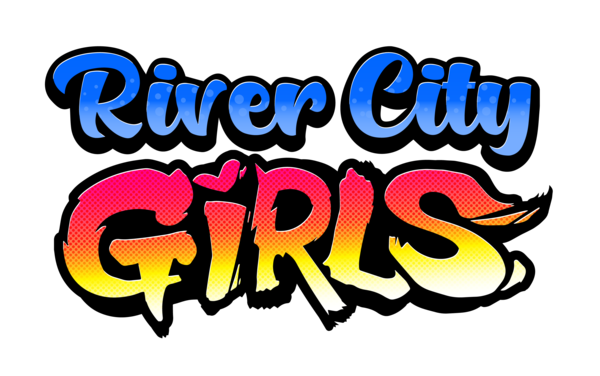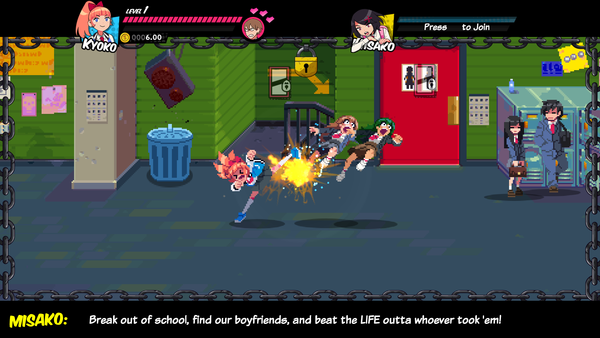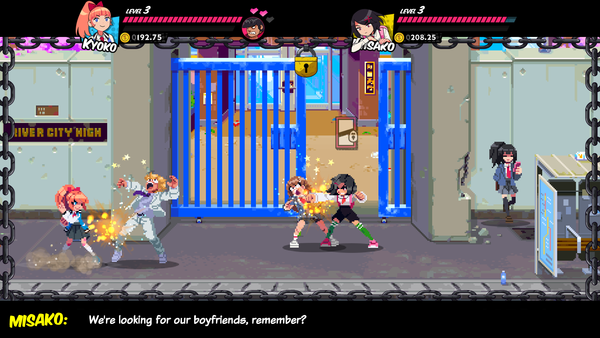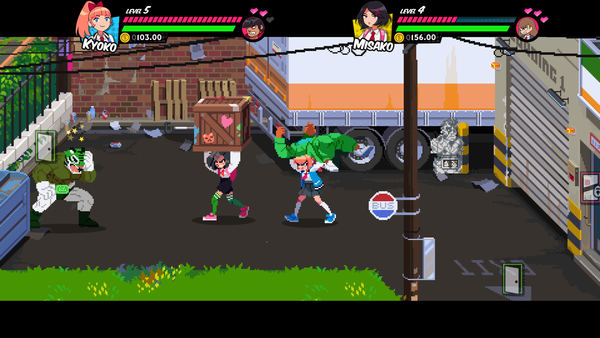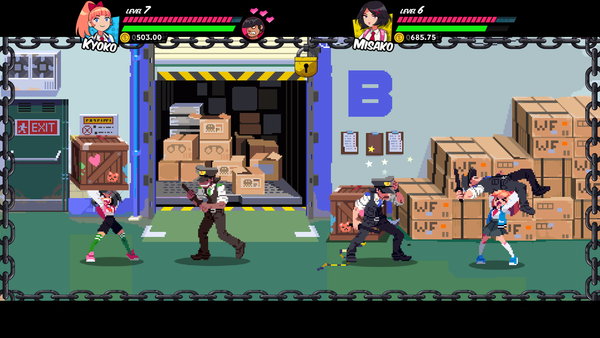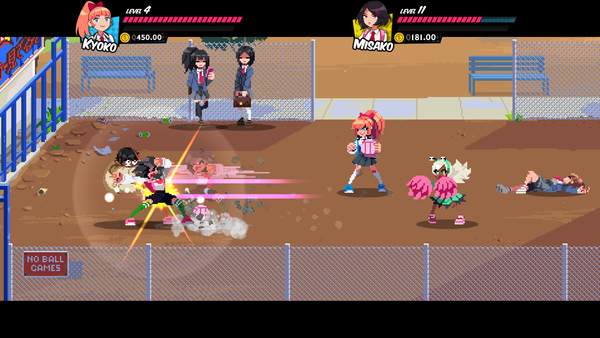Dear Reader:
GoNintendo Interview: We talk to WayForward about all things River City Girls!
Longtime GoNintendo fans know that I'm a HUGE fan of WayForward's work. No joke, they're one of my favorite developers out there! From their original titles to work on other big-name franchises, I think they nail it every single time. No matter what they're cooking up, I always look forward to it.
I also happen to be a really big fan of the River City franchise! That love affair started way back on the NES, and has continued to this very day. I mean, how can you not love a franchise where the bad guys say "BARF!" when you beat them down?!
Imagine my excitement when I found out that Arc System Works and WayForward were teaming up to make a new spin-off title in the River City franchise called River City Girls! As soon as the first trademark popped up I was dying to know more, and when I found out WayForward was involved, I couldn't have asked for anything better. Best of all, River City Girls is launching for Switch on Sept. 5th, 2019, which is right around the corner!
Looking for a way to keep yourself occupied until River City Girls launches? Why not check out our interview with WayForward's Adam Tierney? We picked his brain to find out all sorts of juicy details on the upcoming title, and even had a hunch or two confirmed!
Q1. What drew WayForward to the River City franchise?
A1. “River City Ransom” is one of those classic NES games that I think WayForward has always had an eye on as something we’d love to take a stab at adapting. We got close back in 2012 with “Double Dragon Neon;” the Kunio-kun (aka River City) series and Double Dragon series have always been loosely connected. But it wasn’t until a few years ago that we made a formal inquiry about River City to Arc System Works, who gained the rights to both brands back in 2015.
Arc has actually been really busy with the brand since acquiring it, creating remakes and original games on 3DS and consoles. And of course there was also renewed attention on the brand here in the States from the Kickstarter game project “River City Ransom: Underground,” which was directed by Bannon Rudis (now a director here at WayForward, and assistant director on “River City Girls”).
But to single out one moment in particular, it was when I was first shown the Super Famicom game “Shin Nekketsu Kōha: Kunio-tachi no Banka.” This game had inexplicably missed my attention until a few years ago, when another director here showed it to me. Misako and Kyoko (the two heroes of “River City Girls”) were secondary playable characters in that game, and I immediately fell in love with their designs, their personality, and the fact that these very scrawny-looking female characters were destroying huge, bulky thugs with ease. The second I saw them curb-stomping a downed gangster, I knew we needed to create a new game based on these girls.
Shortly afterward, we teamed up with comic artist Priscilla Hamby (@Tsulala) to reimagine Misako and Kyoko, as well as some additional boss characters (new and old), and pitched the concept to Arc System Works while on a business trip to Japan. Arc had a really positive reaction to the pitch, and not long afterward, we were collaborating with them on “River City Girls” as a brand new, Western-developed entry in the Kunio-kun franchise.
Q2. What do you think the River City universe provides that other beat'em-ups don't?
A2. More than anything, I think it’s the series’s humor. Under the hood, there’s a lot of the same DNA between Double Dragon and River City games, but the Double Dragon games (Neon excepted) were always epic and serious, while the River City games were always slapstick and cartoony. Beaten enemies yelling “BARF!” or picking up and throwing a downed enemy like a weapon gives the series a ridiculous, larger-than-life feel that was pretty well realized way back in “River City Ransom” (the third game in the Kunio-kun series) and that has remained to this day.
“River City Girls” keeps that absurdity in place, while maybe exploring it even further than previous titles. One of my favorite VO lines in the game is when Kyoko (one of our two protagonists) ponders, “You ever wonder why everyone in our town is so violent? I mean, everyone's always punching and kicking each other. Like, everywhere we go, all day long.” That’s the kind of goofy conceit I would wonder about if I lived in the world of a beat-’em-up game, so it’s fun to have characters actually ask that aloud. And hopefully, through the humor and gags, players will become attached to our characters on an emotional level as well.
Q3. What made you want to put the ladies in the lead for this outing?
A3. It was a few things. First, as mentioned, just really falling in love with them in “Shin Nekketsu Kōha: Kunio-tachi no Banka.” Second, I think WayForward just gravitates toward (and is pretty well known for, at this point) creating games with strong female protagonists. So of course the WayForward version of a River City game would star the girls, right? And third, it seemed like a nice way to mix up the formula, which seemed pretty critical given there are around 50 Kunio-kun games that’ve been released over the past 30 years. Taking the spotlight off the boyfriends, Riki and Kunio (who star in about 90% of the Kunio-kun games), felt like something that might interest long-time Kunio-kun fans rather than if we just maintained the status quo and let the boys lead this game as usual.
One funny thing, though, is that confusion about which girls to use ended up brewing up one of the game’s major plot points. Our first pitch to Arc had Misako and Kyoko as the lead characters because they were the playable characters in that Super Famicom game. But I didn’t realize at the time that Hasebe and Mami (aka Roxy and Cyndi) were actually the boys’ girlfriends in MOST of the Kunio-kun games. We’d sort of stumbled into selecting the “rare girlfriends” as our protagonists. And as we discussed how to handle that in the game, that sort of brewed up this rivalry between Misako/Kyoko and Hasebe/Mami that’s woven into much of the game’s plot now. It’ll be fun, when the game is released, to see how series fans react to the dynamic of these four girls in our game.
Q4. River City Girls seems to be a great mix of WayForward's signature style and Arc System Works' mechanics. How hard was it to find this balance?
A4. Brawlers are one of the game genres pretty firmly in WayForward’s wheelhouse, the others being platformers and metroidvanias (and “River City Ransom” has a lot of metroidlike DNA as well). So it was pretty natural for us to work on a game of this type. Where I think the game got more interesting in its combat systems, and to your point much closer to Arc’s own fighting games, is when we decided to bring Bannon on as my assistant director. Bannon designed and oversaw all the game’s combat, enemies, and boss battles. He’d effectively been living in River City for four years before joining WayForward, through his work on “River City Ransom: Underground.” And that game was pretty ambitious in terms of its combat systems, combos, juggling, etc.
On “River City Girls,” Bannon brought his brawler and fighting game expertise, but at the same time kept the play controls and inputs simpler than in many fighters and brawlers, so that pretty much anyone can pull off any move they choose to. I would liken the combat to Super Smash Bros. or Arc’s own Dragon Ball FighterZ, both of which are very deep, nuanced fighting games, but inputting each move is always as simple as pressing a direction plus one button. Bannon also loves contextual combat moves, so there are a lot of attacks in “River City Girls” that are pulled off by attacking enemies mid-air, or from behind, or when on the ground, or jumping on their head. And again, the combat is also very charming and silly, which really helps reinforce the personality of the girls, bosses, and enemies in the game.
Q5. Wayforward's games, in my opinion, have some of the best soundtracks around. How important was it to find the right sound for River City Girls?
A5. Massively important! And thank you for saying that.
I decided very early on that I wanted to develop “River City Girls” with an almost entirely new staff, in regard to art, animation, and music. The folks we typically work with (both internal and external) are great, but this game needed to have its own distinct personality. I’d been wanting to work with Chipzel for years, so this seemed like a great opportunity to bring her aboard (she’d previously contributed to one of our Adventure Time games). Chipzel composed the game’s boss battle songs, which I wanted to have a heavier, more aggressive sound than the rest of the game’s music.
For the stages, cinematics, menus, and most everything else, we tapped Megan McDuffee, who’s a real rising star of synthpop and indie film scores. With Chipzel already planned, I wanted another composer to balance out the soundtrack with more mellow, symphonic tracks. Megan nailed that vibe and then took it so much further than I could’ve imagined. She personally composed about 50 tracks on our 62-song soundtrack, and they are all ridiculously hummable. Not to mention Megan is also a very gifted singer, so she created a half-dozen full vocal tracks as well, and those tie into one of the game’s bosses in an interesting way.
Nathan Sharp (NateWantsToBattle), Cristina Vee (who also cast and directed our VO), and Dale North round out our collection of composers, and they all did an awesome job on their songs.
Q6. The manga-style snippets are such a fresh way to delivery story content. How did that come to be?
A6. They began mostly out of pure necessity. There are about five manga sequences in the game and we used them for storytelling beats that would’ve been difficult to achieve through in-game dialog alone. I decided at the start of production that I didn’t want to do any “scripting” sequences, which is when the game takes control of your characters and walks them around. Those are always a ton of effort to pull off, and (at least in pixel games) they usually come off stiff and bland.
So instead, we created little motion comics that turned out really fun and engaging, more so than I think we initially expected. We’re pretty much doing the Fooly Cooly manga thing of panning the camera around over a page of comic book art with VO and minor animation. I wrote these scenes, Priscilla illustrated them, Cristina directed the VO, Jordan Vine (one of our VFX artists) animated them, Megan created music, and Kevin Samuels in our SFX department added sound effects. These manga scenes ended up being some of the team’s favorite moments in the game, and (relative to everything else) they weren’t that hard to pull off.
We also have full-animation, anime-style scenes, but those are reserved for the game’s intro title sequence and the reveal of each boss (just before their battle). I’m also fond of how those sequences came out, but they took drastically more effort than the manga comic sequences. And of course we have the WayForward-standard slide-in-portrait scenes, as well as passive VO that plays during combat. And 100% of our story sequences that pause gameplay are skippable if players just want to get back to the action.
Q7. Misako and Kyoko seem to have an expansive set of moves to choose from. Where did the inspiration for these come from? Did we catch a little bit of pro wrestling influence in there?
A7. Absolutely. Bannon loves wrestling (in fact, I believe he’s taking a wrestling class currently) and I recall he leaned heavily into those types of moves in “River City Ransom: Underground.” When it came to our game, the primary goal was to make the combat of each character — be they playable, enemy, or boss — clearly tied to their individual personality. Bannon worked with our lead animator, Kay Yu, to decide what each of the girls’ attacks should look like, and I was impressed with how creative they got. The fact that Kyoko has a devastating dab attack made me groan when I first saw it, but I knew people would love the absurdity of it (and since that move was revealed online recently, sure enough, people have been obsessing over it). But it’s also a very Kyoko thing to do. You really get a clear sense of the personality of each girl by watching how they attack and move around in the game, which is a real testament to the abilities of Kay, Bannon, and the rest of our animators — that they were able to craft combat this tight and responsive, while also making it very charming and silly.
Q8. Will the game make use of any Switch-specific features?
A8. The game is playable in both docked and handheld mode, of course, and has a robust layer of HD Rumble over all gameplay elements. But probably the best Switch feature is that the combat inputs are concise enough that the game can be played two-player with a pair of sideways Joy-Cons. Bannon was very adamant about ensuring the inputs never got numerous enough to require two Joy-Cons for one player. Single players can similarly play it with a sideways Joy-Con, two upright or docked Joy-Cons, or a Switch Pro Controller — however they prefer.
Q9. The game is couch co-op only. What made you stick to this classic style of multiplayer?
A9. There are a metric TON of gameplay systems in the River City games. People are always quick to remember that the games are brawlers, but sometimes forget there’s a full metroidvania layer underneath that, and then a full stats-and-leveling system under that. Couple this with the fact that we were working in a brand-new art style (couldn’t reuse any of the classic Kunio-kun sprites or environments, as most previous games had), and then added some brand-new design elements to this game, such as accessories (permanent, swappable stat-boosts) and recruits (converting defeated enemies into jump-in allies), and online co-op just couldn’t fit into the schedule this time around.
I know this is disappointing news for many gamers, but including online with our schedule really would have meant taking a hatchet to several of the (IMO) more memorable gameplay systems we did get in. If we’re fortunate enough to develop another River City game after this one, I think online is something we would make an effort to try and get in, but for this first game, with everything else we had to complete in a short amount of time, it just wasn’t feasible.
That said, I do want to mention that the game’s story doesn’t suffer from playing alone. Whether you’re in a one-player or two-player game, the story is always unfolding for Misako and Kyoko together. So you still get all the same jokes, story beats, and friendship moments between Misako and Kyoko whether or not both girls are actively being played. The game also accommodates swapping back and forth between one- and two-player at any time, and under any save file. Even though you might’ve started a game solo, if you have a friend visiting, they can jump right into the game and help you out on your quest.
Q10. Can we expect any animated shorts to go along with the game? Something akin to what SEGA did for Sonic Mania Plus?
A10. Man, I wish! Unfortunately that’s not currently planned, mostly because the people who would be working on those are too busy finishing the actual game. Also, given how long it takes to produce quality 2D animation, I think a preferred route might be the motion comics w/ VO we were just discussing, or maybe even a typical, old-school, physical comic book. If “River City Girls” sells well, I think any of these options — and especially more games — is a possibility.
Q11. Before we go, can you tell us one more tidbit about ANYthing in the game that you haven't shared anywhere else?
A11. Hmmmm... Something we haven’t shared ANYWHERE else yet? That’s tough because so much of the game’s cast and locations and gameplay systems have already been revealed in the many websites, trailers, and interviews that WayForward and Arc have released.
Okay, you’d think that a game with six worlds would contain six boss battles. But you’d be mistaken. There’s still one boss deserving of a beatdown after the credits roll. If you think cleverly, maybe you can find them...
A HUGE thank you to Adam Tierney and the entire WayForward gang for putting together this interview with us. It was our pleasure to work on the feature, and I hope all of you reading this enjoyed it!
